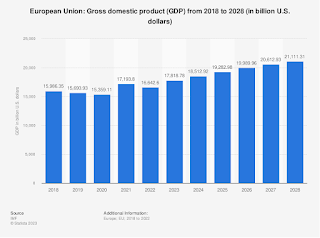Europe GDP Growth Forecast
Europe GDP Growth Forecast, Europe, a diverse and economically significant continent, is always in the spotlight when it comes to economic trends. Understanding Europe's GDP growth forecast is crucial for policymakers, investors, and anyone interested in the region's financial well-being. In this article, we will delve into the factors influencing Europe's GDP growth, the impact of the COVID-19 pandemic, recovery measures, industry-specific analysis, geographical variations, and the challenges ahead.
Understanding GDP Growth
Gross Domestic Product (GDP) measures the economic performance of a country or region. It is the sum of all goods and services produced within a defined period. To forecast GDP growth, economists examine various factors that can influence economic development.
Factors Influencing GDP Growth
Fiscal Policies
Fiscal policies, including government spending and taxation, play a pivotal role in shaping a nation's economy. The European Union (EU) member countries often coordinate their fiscal policies to ensure stability and growth.
Monetary Policies
Central banks, like the European Central Bank (ECB), influence GDP growth through interest rates and money supply management. These policies aim to control inflation and promote economic growth.
External Trade
Global trade relationships are crucial for Europe's GDP. Exports and imports significantly impact economic performance, as Europe is a major trading partner for many countries worldwide.
European Economic Trends
Before delving into forecasts, it's essential to analyze current trends. Europe has historically shown steady growth, but recent years have been marked by slower progress due to various global challenges.
Impact of the COVID-19 Pandemic
The COVID-19 pandemic took a severe toll on economies worldwide, and Europe was no exception. Lockdowns and disruptions in supply chains resulted in a significant economic setback.
Recovery Measures
The European Recovery Plan
The EU has taken proactive steps to combat the economic fallout of the pandemic, with the €750 billion European Recovery Plan. This plan aims to boost economic recovery and promote sustainable growth.
Digital Transformation Initiatives
Digital transformation is at the forefront of Europe's economic recovery. Investments in technology and innovation have become crucial to adapt to the changing business landscape.
Industry-Specific Analysis
Technology Sector
The technology sector has been a driving force behind Europe's recovery. Companies in this sector have adapted quickly to the digital shift, leading to job creation and economic growth.
Tourism Industry
The tourism industry, on the other hand, faced severe disruptions due to travel restrictions. However, with the easing of restrictions, this sector is gradually recovering.
Geographical Variations
Europe is not uniform in its economic performance. Northern and Western European countries often lead in terms of GDP, while Eastern and Southern European nations face different challenges.
Challenges Ahead
The path to sustained GDP growth in Europe is not without obstacles. These challenges include economic disparities, sustainability goals, and adapting to a rapidly changing global landscape.
Conclusion
Europe's GDP growth forecast is a topic of great interest, especially in the wake of the COVID-19 pandemic. While the region has faced challenges, proactive measures and industry-specific strengths have positioned Europe for a promising future.
FAQs
1. How has the COVID-19 pandemic affected Europe's GDP growth?
The pandemic resulted in a significant economic setback in Europe, leading to a contraction in GDP. However, recovery measures are in place to address this.
2. What is the European Recovery Plan, and how does it impact GDP growth?
The European Recovery Plan is a €750 billion initiative aimed at boosting economic recovery and promoting sustainable growth in the region.
3. Which industries have contributed significantly to Europe's economic recovery?
The technology sector has been a driving force behind Europe's recovery, with rapid adaptation to the digital shift.
4. Are there geographical variations in Europe's GDP growth?
Yes, there are geographical variations, with Northern and Western European countries often leading in terms of GDP, while Eastern and Southern European nations face different challenges.
5. What are the key challenges Europe faces in maintaining GDP growth?
Europe faces challenges such as economic disparities, sustainability goals, and the need to adapt to a rapidly changing global landscape.




Comments
Post a Comment